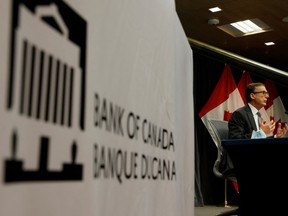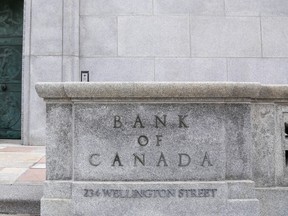Kevin Carmichael: The signs were there even before Friday’s game-changing speech
Article content
The Bank of Canada almost certainly will take the steeper path to higher interest rates when its leaders meet next month to reset policy.
Advertisement 2
Article content
Many observers would have come to that conclusion before Deputy Governor Sharon Kozicki’s game-changing speech on March 25.
Her boss, Tiff Macklem, said after he and his deputies raised the benchmark rate a quarter point on March 2 that the pace of future increases would be guided by data. The data over the past few weeks show the economy is considerably stronger than the central bank expected at the start of the year.
The jobless rate was 5.5 per cent in February, near a modern low, and the consumer price index averaged year-over-year increases of 5.4 per cent over the first two months of the year, compared with the Bank of Canada’s January forecast of 5.1 per cent in the first quarter. That outlook preceded Russia’s invasion of Ukraine, which has destabilized the supply of oil, natural gas, agricultural staples and metals. “The result is inflation in the near term that is expected to be higher than we projected in January,” Kozicki said.
Advertisement 3
Article content
Higher interest rates won’t guarantee rain on the Prairies this summer, and Macklem has no influence over international oil prices. Bay Street economist David Rosenberg’s argument that central banks are about to trigger a recession is a good one. Alas, if you’re Macklem, and your primary job is keeping year-over-year increases in the consumer price index at about two per cent, the most recent set of data leave you with only one choice: reel faster.
Still, many of the men and women who get paid to predict where interest rates are headed still were hedging their bets at the start of last week, perhaps because Macklem had said on March 3 that he and his lieutenants “fully intend to tighten policy in a deliberate and careful way, being mindful of the impacts and monitoring the effects closely.” But that was before the unemployment rate plunged to a level consistent with full employment; Statistics Canada reported that there were 915,500 unfilled jobs in the fourth quarter, 63 per cent more than a year earlier; and inflation went from hot to hotter.
Advertisement 4
Article content
Under Stephen Poloz, the previous governor, the Bank of Canada moved away from pointing Bay Street and Wall Street in the direction of where interest rates were headed. Poloz believed professional investors and analysts had started putting more effort into reading between the lines of central bankers’ speeches, depriving markets of the kind of rigorous analysis that ensures price discovery. Bay Street was furious when the Bank of Canada cut the benchmark interest rate in January 2015 without any notice. Poloz’s response, essentially, was that anyone who was watching the data should have seen it coming. Oil prices had collapsed, and history was clear on what happens to Canada’s trade dependent economy when the value of its most valuable export plunges.
Advertisement 5
Article content
Macklem is more open to a little handholding. He took some heat in January for opting to leave interest rates unchanged, even though all the boxes for an increase had been checked. There will be no ambiguity ahead of the next policy decision on April 13. Kozicki telegraphed a relatively aggressive half-point increase, instead of the customary quarter-point change, and indicated that policy-makers likely will likely stop buying government bonds, a process called quantitative tightening, or QT.
“I expect the pace and magnitude of interest rate increases and the start of QT to be active parts of our deliberations at our next decision in April,” Kozicki said in remarks prepared for a conference hosted by the Federal Reserve Bank of San Francisco. “The reasons are straightforward: inflation in Canada is too high, labour markets are tight and there is considerable momentum in demand.”
Advertisement 6
Article content
Kozicki’s steer had the desired effect. The dollar jumped and bond yields rose. Veronica Clark, an economist at Citigroup Global Markets Inc., changed her forecast, and now predicts half-point increases in April, June and July, followed by a series of quarter-point lifts that leave the benchmark rate at 2.75 per cent at the end of the year, compared with 0.5 per cent currently.
“The hawkish tone of the speech swings the door wide open to more aggressive rate hikes,” Benjamin Reitzes, an economist at BMO Capital Markets, said in a research note.
Kozicki probably didn’t need to play the role of Walmart greeter, pointing analysts to the “half-point-in-April” aisle. Several of her counterparts at the U.S. Federal Reserve, including Jerome Powell, the chair, made similar comments about their own intentions last week. The Bank of Canada doesn’t always follow the Fed, but with inflation at risk of running away, the Canadian central bank couldn’t allow a gap to open between interest rates in the two countries. That likely would cause the Canadian dollar to weaken, which would put more upward pressure on prices by making imports more expensive.
Advertisement 7
Article content
More important was a new set of conclusions that Kozicki shared about the sensitivity of Canada’s highly indebted households to higher borrowing costs. She said that about three quarters of mortgage holders have fixed rates, mostly on five-year terms, so about 20 per cent renew in a given year. That means anyone renewing over the next couple of years will end up with lower payments, because interest rates were that much higher five years ago. Central bankers can worry less about choking demand in the near term, and more about inflation. “We see that households on average appear to be in better financial shape now than at the start of our 2017-18 tightening cycle,” Kozicki said.
That cycle started with a quarter-point increase in July 2017. Policy-makers then took a gentle path, slowly raising the interest rate to 1.75 per cent in October 2018, which was as high as they managed to go. It’s safe to assume that this time will be different.
• Email: kcarmichael@postmedia.com | Twitter: carmichaelkevin
Advertisement
The Bank of Canada will almost certainly take the steeper path to higher rates next month
2022-03-28 12:23:41






